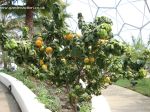Categories
Calendars
Guides
- Help on the Allotment
- Greenhouse World
- The Perfect Lawn
- Water Garden Features
- Beginner's Corner
- Pest and Disease
- Garden Techniques
Reviews
Archive
Gallery
Articles
Ask Our Gardening Expert
Eden Project Warm Temperate Biome (page 2)
Eden Project Warm Temperate Biome
(page 2)
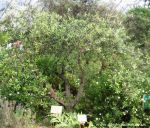 The olive tree is one of the earliest plants appearing in
literature. The Greeks loved them! It is a native of the East
Mediterranean and can grow in very harsh conditions. Drought is no
problem for an olive tree.
The olive tree is one of the earliest plants appearing in
literature. The Greeks loved them! It is a native of the East
Mediterranean and can grow in very harsh conditions. Drought is no
problem for an olive tree.
They take several years before producing olives but can live for two hundred years or more.
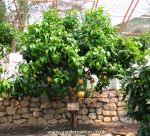
A grapefruit tree in the temperate biome at the Eden Project. This picture was taken in late April so the fruits are not yet fully-formed.
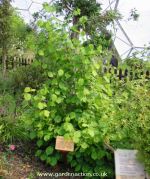 On the left is a Hazel tree which normally grows to about 6m
tall but can grow as high as 15m. It is native to many areas in
Europe, including the UK, and Asia.
On the left is a Hazel tree which normally grows to about 6m
tall but can grow as high as 15m. It is native to many areas in
Europe, including the UK, and Asia.
Interestingly, the hazel tree is home to truffles which grow just below the soil surface around the roots of the tree. In the UK, hazel was grown as coppice and the branches and twigs were used for building walls and fencing.
The plant on the left is Acokanthera, commonly known as Bushman's Poison. The bushmen (Khoisan) used the sap to bind together the poison tips of their arrows. The sap itself is highly poisonous as are most other parts of this plant.
In small amounts,
the plant is used to treat snake bites, intestinal worms and reduce
aches and pains. I know I'm not going to try it! 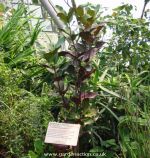
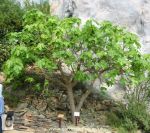
Fig trees can grow in tropical and temperate climates. The "fruit" of the fig tree is unusual in the the flowers are on the inside of the fruit. The fig relies on small wasps to pollinate it. They crawl inside a small opening of the fruit. The wasps in turn extract food from the fruit.In temperate zones, the wasps hibernate inside figs.
The Seville orange is mainly grown in Mediterranean areas. The fruit
is much more bitter compared to a sweet orange making it ideal for
marmalade amongst other things.
The high pectin content helps the marmalade to set better.
